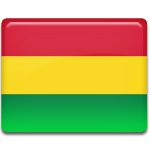Independence Day in Bolivia Date in the current year: August 6, 2026
 August 6 is Independence Day in Bolivia. This public holiday commemorates the establishment of the Republic of Bolivia (now the Plurinational State of Bolivia) in 1825.
August 6 is Independence Day in Bolivia. This public holiday commemorates the establishment of the Republic of Bolivia (now the Plurinational State of Bolivia) in 1825.Thousands of years ago, the territory of present-day Bolivia (to be more precise, its western part) was home to Tiwanaku, one of the most powerful Andean civilizations. They disappeared around AD 1000, leaving the area uninhabited for centuries. In the 15th century, the Inca empire gained control over much of the territory now known as Bolivia.
The Spanish began their conquest of the Inca empire in the early 16th century, gaining control over most of its territory by 1533. The territory of what is now Bolivia was named Charcas, and was under authority of the Viceroy of Lima. The area was important for the Spanish Empire because of its rich silver reserves. In 1776, Charcas was transferred to the authority of Viceroyalty of the Río de la Plata, and the residents of Buenos Aires started referring to it as “Upper Peru”.
As a result of Napoleon Bonaparte’s invasion of the Iberian Peninsula in the early 19th century, the Spanish Empire began to lose control over its American colonies. Although the local elites of Charcas remained mostly loyal to the Junta Central of Spain, there were a lot of people who wanted independence from Spain.
On May 25, 1809, the citizens of Sucre (then Chuquisaca) organized a popular uprising against the colonial authorities. It was followed by the La Paz revolution on July 16. Although both uprisings were defeated by the authorities, they sparked the Spanish American wars of independence. The Chuquisaca Revolution is often referred to as the “First libertarian scream” (Primer grito libertario).
During the Bolivian War of Independence, the region was captured and recaptured many times by the royalists and patriots. However, Spain never regained full control of Upper Peru. The main proponents of the idea of Bolivian independence were six guerrilla groups that controlled areas called republiquetas.
Meanwhile, Spanish-Argentine general José de San Martín and Venezuelan leader Simón Bolívar were endeavoring to liberate as much of Latin America as possible. With their assistance, Peru declared in independence in 1821, and next came Upper Peru’s turn.
The turning point was the Battle of Ayacucho, in which royalists were defeated by the combined forces of Peru and Gran Colombia. It consolidated the independence of Peru and paved the way towards the independence of Upper Peru. On April 25, 1825, Antonio José de Sucre liberated Chuquisaca, and on August 6, Upper Peru declared its independence. The newly independent republic was named Bolivia after Simón Bolívar.
Bolivia Independence Day (Dia de la Patria) is a national holiday celebrated throughout the country. It is marked with colorful street parades, military displays, gun salutes, civic ceremonies, open-air performances, carnivals, dancing and other festive events and activities. The biggest celebrations are held in the cities of Sucre and La Paz. Sucre is the official capital of Bolivia, while La Paz is the seat of the government.
- Category
- Public Holidays
- Country
- Bolivia
- Tags
- Independence Day in Bolivia, holidays in Bolivia, public holiday, national holiday, Simón Bolívar